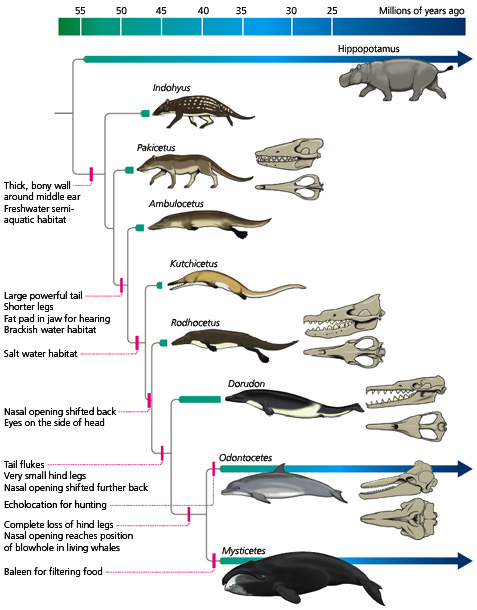Barbarian notes that Gingrich accurately demonstrated that nostrils/blowholes show transitional forms in whales.
Of course. The transition:
was obvious as soon as we started finding fossil whales. It's just one of many ways in which they are transitional.
He is still pushing that nonsense?
See above. No point in denial. It's why your fellow creationist Kurt Wise said that cetacean fossils are "strong evidence" for evolution.
Gingerich was interviewed by Werner at a later date.
Yep. After the postcranial skeleton of Pakicetus was found. Surprisingly, it had a very whale-like skull, and a body only slightly adapted to water. This points up Gould's note that evolution tends to make "mosaics", with different features evolving at different paces.
Gingerich initially promoted Rodhocetus as a fluke-tailed swimmer.
It might have had a fluke. But it retained legs capable of propulsion. The tail was large, muscular, and broad, meaning it aided in movement. Whether or not it had a broadened fluke at the end is unknown.
A repositioned nostril (if that is what it is)
That's what a blowhole is, yes. And it's an important part of whale evolution, since it make breathing easier in motion. But as you now realize, it's just one of many such transitions.
As a rationalist, it appears to be an extinct species to me: probably a form of alligator of crocodile.
Nope. No one with even a superficial knowledge of anatomy and mammals would think so. For example, it has a single bone in the lower jaw, and the mammalian middle ear. It lacks cervical ribs and has many, many other mammalian features.
Pakicetus is, as your fellow creationist admits, very good evidence for evolution.
Nope. In fact, the skull is so whale-like, it was assumed to have a very whale-like body. It was quite a surprise to find that it was only slightly evolved for water in its post-cranial skeleton. As Kurt Wise says, it's evidence for the evolution of whales from land animals, exactly what the theory predicted before it was found.
Then Ambulocetus:
Nope. Ambulocetus is more adapted for water. It could still get around on land, somewhat like a sea lion, but it was clearly more comfortable in the water. Notice the rear feet are large and broad, like tose of otters, to swim more efficiently. The evolution of these primitive whales explain why modern whales have horizontal flukes; they evolved from the mammalian swimming motion.
Then Rodhocetus:
Nope. As you see, Rodhocetus was even less adapted for land than Ambulocetus, and with those tiny front legs, probably had a great deal of difficulty in moving around.
And then Dorudon, which retains legs, but clearly could not move around on land:
From more primitive whales. And now you understand why your fellow YE creationist, Dr. Wise, admits that these transitionals are strong evidence for evolution.
Unless there is a plethora of transional forms,
When I was young, we hadn't found any other than Basilosaurus. All we had were predictions. And now, we have a plethora of such transitional forms. A partial list of just the Archocetes:
Family Ambulocetidae
(Eocene)
 Dorudon
Family Basilosauridae
Dorudon
Family Basilosauridae
(Late Eocene)
Basilosaurus cetoides reconstruction
Family Kekenodontidae
(Oligocene)
Family Pakicetidae
(Early to Middle Eocene)
Ambulocetus skeleton in front and
Pakicetus behind
Family Protocetidae
(Eocene)
Rhodocetus kasrani reconstruction
Family Remingtonocetidae
(Eocene)
List of extinct cetaceans - Wikipedia
There's lots more. Want to see more?
There is another way to look at it, which I heard or read somewhere:
"Thousands of paleontologists since Darwin have found no whale transitions."
"Two paleontologists have discovered Rodhocetus,Ambulocetus, and Pakicetus."
And now you know better.
Which paleontologists have the most vivid imaginations?
The ones who predicted all those transitional forms before they were found?
Know what's even more impressive than that? We never find one that the theory says should exist. No whales with gills, no whales with horozontal swimming motions. Just the predicted forms. This is why even knowledgeable creationists admit that these transitions are strong evidence for evolution.










